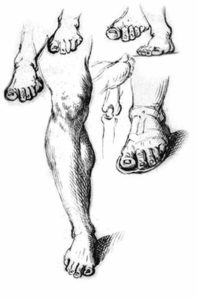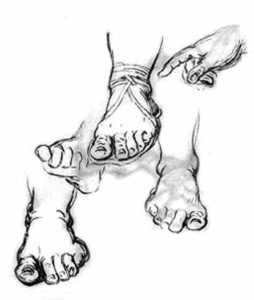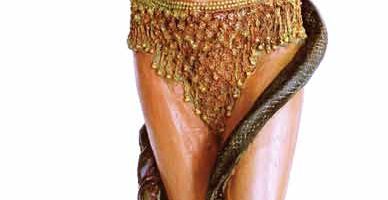
My Jewish Feet
 I have, according to a dubious assemblage of pundits, propagandists, and pseudoscientists, Jewish feet. What I thought was familial is, in the eyes of some, tribal. My feet are flat. They turn out. In podiatric lingo, they pronate. Pes planus, in medspeak and Latin. Liopothes, or “people with smooth feet,” wrote Greek physician Galen, who was the first to describe flat feet in the medical literature.
I have, according to a dubious assemblage of pundits, propagandists, and pseudoscientists, Jewish feet. What I thought was familial is, in the eyes of some, tribal. My feet are flat. They turn out. In podiatric lingo, they pronate. Pes planus, in medspeak and Latin. Liopothes, or “people with smooth feet,” wrote Greek physician Galen, who was the first to describe flat feet in the medical literature.
When I was eight or nine, my parents took me to an orthopedist. He assessed my walk, took some measurements, prescribed orthotics. I suppose I wore them, but I don’t remember. I felt ashamed. Wasn’t walking as natural as breathing? How could I screw up? (“It should be noted,” reads an entry in Reference. com, an online encyclopedia, “that … horses also develop flat feet.”) Already I was round-shouldered and prepubescent. Too tall. Too smart. Unathletic. I scored in the lowest percentile for the number of knee lifts I could do while hanging from the bars in gym (ten).
My feet, or more specifically my walk, seemed to be a source of family tension. I walked like my father. My mother used to say we walked like ducks. When she walked behind us, she was amused by the similarity of our turned-out gaits. Something in her amusement suggested superiority. She had high arches. Aristocratic feet. Never mind that she wore heel pads in her shoes, sorry slabs of beaten leather. Or that she and my father both came from Russian-born parents who’d fled the pogroms. Her father was a sign painter, his a tailor. Somehow she was high class and we were low. We — father and daughter— were among the fallen, the downtrodden, the miserable flat-footed. Nate Shinner and his gawky daughter, one imprinting on the other.
Over the years my feet went unreformed. And later it was my lover, not my mother, who noted them. She too seemed amused — the way you’re amused, smitten almost, by the most familiar traits of the one you love. We were walking back to the car after seeing a performance of Evita. My father, brother, and I in front, Ann and my great-aunt behind. My father was still shaken by the image of Eva Peron’s coffin being carried across the stage. His sadness annoyed me. Did he have to be so self-absorbed? Did everything have to remind him of my mother’s death, even though, at the sight of the coffin, I thought of her too? My mother’s life, like Eva’s, prematurely occluded (Eva was thirty-three when she died, my mother fifty-six — not nearly as young as Eva, but young enough).
Meanwhile, Ann, a few steps behind, had a different view. She and my aunt saw, not Eva’s coffin hoisted above the shoulders of her grief-stricken followers, not Che Guevara singing “Oh, What a Circus” at the edge of the crowd, but instead parent and progeny traipsing down Randolph, lock-stepped in harmony. And they were tickled. Look at them. Can you believe it? They walk the same. Those Shinners. Three ducks in a row. We were so endearing.
So what’s Jewish about my feet, planted under my desk and swaddled, for warmth and comfort, in SmartWool? I look down at them, and even through the socks I see the rounded contours of the first joints of my big toes. The bump on my left toe is bigger. Bunions, I suppose, but they’ve always been there, part of my geography. Once, at a sleepover, my cousin pointed at one of them and asked me what that was, but I had no idea what she meant. My feet were ordinary.
Or not. History has weighed in on my body, and I have come up . . . Jewish. The evidence? Since the Middle Ages, the Jewish foot has been characterized as ugly, misshapen, flat, even cloven, like that of the he-goat and his close relative, the devil. And just as I sit here wearing socks that disguise my feet, but not really, so too have shoemakers, throughout the centuries, concealed the Jewish foot, but barely, and enabled the Jews, with their telltale feet, to pass, sort of. (Shoemaking has long been a common trade among Jews. At the turn of the twentieth century, for instance, there were 730 Jewish shoemakers in Algiers and 2,890 in London.) How do you ( Jews) recognize each other? British writer Clive Sinclair was asked during a trip to Bulgaria in the early 1990s. Do you “give each other [secret] signals?” Sinclair paused for a moment before lifting his pant leg. “That’s what we do,” he deadpanned. “We show each other our cloven hooves.”
And on it goes. English scholar and vicar Robert Burton, in his sui generis Anatomy of Melancholy (1621), singles out the Jew’s pace, which he labels an infirmity. Johann Jakob Schudt, who chronicled the life of Jews in eighteenth-century Frankfurt, wrote of their “big heads, big mouths, everted lips, protruding eyes…bristle-like eyelashes, large ears, [and] crooked feet.” Late nineteenth-century anatomist Hermann Schaaffhausen linked anatomy to social status and maintained that Jews walked with “the dragging gait of a lower-class individual.” And Nazi caricaturist Walter Hofmann argued that because the archetypal Jew, constructed from wet clay, disobeyed divine orders and arose while the clay was still damp and soft, “the smarty developed after the first few steps extraordinary bandy legs, but also flat feet.”
Whereas gay men are portrayed as limp-wristed, Jewish men — often seen as effeminate and oversexed at the same time — simply limp. “Be out! Be out!” (Der mub hinaus! Der mub hinaus!), a German folk song, “Borkum Lied,” exhorts anyone with “flat feet, crooked noses, and curly hair” who might dare venture to Borkum, a North Sea resort island and German vacation spot. “Out!”

Some Jews have appropriated this hobbling image, viewing it with affection. In a 2000 GQ article about Jewish waiters, one man fondly recalls visiting Ratner’s, a deli on New York’s Lower East Side, with his grandmother. “No waiters ever walked like them. They walked like they were old, even when they were 25. It was almost like they had a walker.” Adds another, himself the owner of a deli in Baltimore, “They schluffed their feet, like they had weights on them.” Apparently the Jewish waiter served up not only food but, in time-honored fashion, suffering as well.
After Schudt and Schaaffhausen and the rest, I can’t help looking at my feet differently. The lens has switched. The reflection’s changed. The nose, yes, there’s always been the nose, but I had that fixed, didn’t I? I had that dead giveaway reconfigured. The hair too — not mine, mostly straight and nondescript—but S.’s, for example, which I’ve long admired: dark, curly, wiry, and undeniably Semitic. But now the feet — and, it turns out, the round shoulders, the unathletic build, the odor even (foetor judaicus, described as “goatish” by thirteenth-century German preacher Berthold of Regensburg and “faint-sweet” by the Nazis) — all are Jewish. All have been marked, catalogued, stigmatized, labeled. Buried in the public consciousness.
Once my friend J., a hospital chaplain, noted, with dawning measures of recognition and chagrin, that a rabbi she had met, with his pear-shaped body, fit a certain image she had of Jewish men. She and Ann and I sat in her living room and nodded. We all saw it, the picture she was looking at.
I glance at my feet again. Instinctively the toes flex and then curl under. My body, under the eye of history, is off-putting. I’ve become a voyeur, forced to step aside and take a peek at myself. It’s not front-page news that our bodies are subject to social forces. I’ve lived my whole life with the collective distortions of my woman’s body — a faddish assemblage of parts, a repellent but tempting port of entry. And certainly women are not alone in facing such scrutiny. Blacks, for example, have long had to carry, counter, reject, ignore, or falter under the burden of their supposedly simian bodies. But I never understood my body as Jewish, a racial construction, or more to the point, a parody, and the view is unsettling. Who is this flat-footed specimen?
In recent history a few celebrated Jews have been denied entry into the military. Albert Einstein, Hank Greenberg, Mel Tormé, Michael Bloomberg: all had flat feet, and all were found unfit for military service (Einstein in Switzerland), although Greenberg, initially classified as 4-F, was eventually inducted into the Army and served for four years in the Pacific during World War II. My father, flat feet notwithstanding, was sent to Mississippi for basic training. He’d never been to the South. He’d never even been out of Chicago. He grew up at the back of his father’s tailor shop in Albany Park, where down the street at the little deli you could order petcha, calf’s-foot jelly. After a few weeks at training camp, he deserted. There was a sign on an outhouse: “For dogs and jews.” The other men called him hymie. (He told me this five weeks before he died, sensing, perhaps, that the game was up, and it was time to unload his secret.) His parents persuaded him to go back. They didn’t want him to be rounded up. Arrested. This was the Good War. He was a good Jew. Soon he was shipped to France and wounded by shrapnel. There’s a picture of him in his uniform. Dark hair. Slight smile. Private First Class Nathan Shinitzky. He looks very handsome.
My mother and I had gone shopping at Marshall Field’s. The shoe department, lingerie, Misses, Junior Miss. On the fourth floor she bought me a charm bracelet strung with pennies, which I knew I should like but didn’t. I preferred the rhinestone jewelry I’d stolen from my neighbor’s house but had to return. Mr. Brown, my mother had said — a shadowy person of her own invention, a kind of warden of bad children — would come and get me if I didn’t give it back. We had lunch in the Walnut Room, where I ordered the Field’s Special Sandwich, a mountain of iceberg lettuce, sliced turkey, Swiss cheese, bacon, and Thousand Island dressing on rye. Now we were going up the escalator, carrying packages. A man behind us, casually and contemptuously, called us kikes. He was insinuatingly intimate. There were other people on the escalator, but it was as if his taunt had cleared a space around us and now we were alone. I felt a cold, obliterating numbness. I knew what the word meant — or, in any case, I knew it meant us. My mother stiffened. I looked at the back of her long wool coat. She seemed to tell me not to look around. I was eight years old, still pudgy with baby fat. The escalator climbed to the next floor and we got off. I had to hurry to keep up with her. We went home and lived the rest of our lives: menstruation, driving lessons, depression, Vietnam. My mother died twenty years later. The rabbi read the Twenty-Third Psalm at her funeral. I’m writing this.
Peggy Shinner teaches in the MFA program at Northwestern University, is a trained martial artist and a life-long Chicagoan. Her work has appeared in numerous journals.
Reprinted with permission from You Feel So Mortal: Essays on the Body by Peggy Shinner, published by the University of Chicago Press. © 2014 by Peggy Shinner. All rights reserved.


